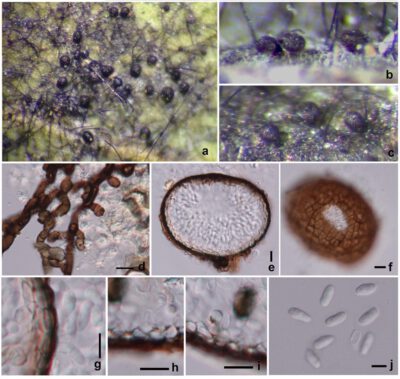Fungalpedia – Note 119 Parameliola
Parameliola Hongsanan, Peršoh & K.D. Hyde
Citation when using this entry: Hongsanan et al., in prep – Fungalpedia, genera and higher taxa introduced in 2016. Mycosphere.
Index Fungorum, Facesoffungi, MycoBank, GenBank, Fig 1.
Parameliola was introduced as an incertae sedis genus in Pleosporales by Li et al. (2016) to accommodate two species, P. acaciae and P. dimocarpi, with the latter the type species. Parameliola species have a hyperparasitic habitat. The asexual morph is characterised by superficial, solitary, globose to subglobose conidiomata, attached to the superficial hyphae of M. thailandicum. The hyphae are branched, septate, darker at the septa, brown to dark brown, with 2-celled, mostly alternate or sometimes opposite hyphopodia. Conidiogenous cells are holoblastic, cylindrical, and hyaline. Conidia are ellipsoid to cylindrical, both ends broadly rounded, aseptate, hyaline, borne singly at the apex of the conidiophore (Li et al. 2016). Parameliola shares similarities with Coniothyrium, but it is distinguished from Coniothyrium and other genera in Pleosporales by its unique hyperparasitic habitat on the thallus or hyphae of Meliola species. Li et al. (2016) successfully obtained sequence data of the two species of Parameliola directly from dry fruiting bodies which contained many conidia. Phylogenetic analyses based on LSU and SSU sequence data revealed that these two species clustered together, but formed a distinct clade separate from other known genera in Pleosporales (Li et al. 2016). Therefore, Li et al. (2016) introduced a new genus, Parameliola to accommodate the two species. Interestingly, these two species of Parameliola did not cluster in any family of Pleosporales in their phylogenetic tree. Li et al. (2016) noted that the Parameliola clade may represent a new family within Pleosporales. However, there is no other record except the original description for the genus. More collections are needed to confirm their placement.
Type species: Parameliola dimocarpi Hongsanan & K.D. Hyde
Other accepted species: Parameliola acaciae Hongsanan & K.D. Hyde
Figure 1 – Parameliola dimocarpi (MFLU15–0045, holotype). Hyperparasitic on the thallus or hyphae of Meliola thailandicum. a-c Conidiomata d Hyphae with hyphopodia. e Section through conidioma in 10 % lactic acid. f Upper wall of conidioma. g Peridium of conidioma. h, i Conidiogenous cells. j Conidia in 10 % lactic acid. Scale bars: d-i = 10 μm, j = 5 μm
Reference
Entry by
Hongsanan S, Research Center of Microbial Diversity and Sustainable Utilization, Chiang Mai University, Chiang Mai 50200, Thailand
(Edited by Kevin D. Hyde)
Published online 22 September 2023
